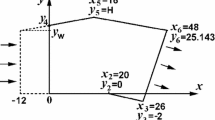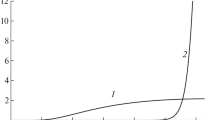Abstract
The principal objective of this paper is to study some unsteady characteristics of an interaction between an incident oblique shock wave impinging a laminar boundary layer developing on a plate plane. More precisely, this paper shows that some unsteadiness, in particular the low frequency unsteadiness, originate in a supercritical Hopf bifurcation related to the dynamics of the separated boundary layer and not necessarily to the coherent structures resulting from the turbulent character of the boundary layer crossing the shock wave. Numerical computations of a shock-wave/laminar boundary-layer interaction (SWBLI) have been compared with a classical test case (Degrez test case) and both two-dimensional and three-dimensional (3D) unsteady Navier–Stokes equations are numerically solved with an implicit dual time stepping for the temporal algorithm and high order AUSM+ scheme for the spatial discretization. A parametric study on the oblique shock-wave angle has been performed to characterize the unsteady behaviour onset. Finally, discussions and assumptions are made about the origin of the 3D low frequency unsteadiness.
Similar content being viewed by others
References
Lighthill M.J. (1950) Reflection at a laminar boundary-layer of a weak steady disturbance to a supersonic stream neglecting viscosity and heat conduction. Q J. Mech. Appl. Math. 3, 303
Lighthill M.J. (1953) On the boundary layer upstream influence ii supersonic flows without separation. Proc R Soc A 217, 478–507
Ribner, H.S. Convection of pattern of vorticity through a shock wave. 2: Technical report, NASA 1953
Kovasznay L.S.G. (1953) Turbulence in supersonic flow. J. Aero Sci. 20, 657–682
Morkovin, M.V. Effects of compressibility on turbulent flows. In: International symposium. on the Mécanique de la turbulence, Paris France, pp. 367–380 1962
Debiève, J.F., Lacharme, J.P. A shock-wave/free turbulence interaction. Turbulent shear layer/shock wave interaction, IUTAM symposium Palaiseau, pp. 392–403 (1985)
Green J.E. (1970) Reflexion of an oblique shock wave by a turbulent boundary layer. J. Fluid Mech. 40, 81–95
Dolling D.S. (2001) Fifty years of shock-wave/boundary-layer interaction research: what next. AIAA J. 39, 8
Smits A.J., Muck K.C. (1987) Experimental study of three shock wave/turbulent boundary layer interactions. J. Fluid Mech. 182, 291–314
Plotkin K.J. (1975) Shock wave oscillation driven by turbulent boundary-layer fluctuations. AIAA J. 13, 1036–1040
Thomas F.O., Putnam C.M., Chu H.C. (1994) On the mechanism of unsteady shock oscillation in shock wave/turbulent boundary layer interactions. Exp. Fluids 18, 69–81
Dolling D.S., Or C.T. (1985) Unsteadiness of the shock wave structure in attached and separated compression ramp flow. Exp. Fluids 3, 24–32
Selig M.S., Smits A.J. (1991) Effect of periodic blowing on attached and separated supersonic turbulent boundary layer. AIAA J. 29, 1651–1658
Degrez G., Boccadoro C.H., Wendt J.F. (1987) The interaction of an oblique shock wave with a laminar boundary layer revisited. an experimental and numerical study. J. Fluid Mech. 177, 247–263
Liou M.S., Edwards J. (1998) Low-diffusion flux-splitting methods for flows at all speeds. AIAA J. 36, 1610–1617
Alfano, D., Corre, C., de la Motte, J., Lerat, A. Assesment of numerical methods for unsteady shock/boundary layer interaction. Boundary and interior layers – computational and asymptotic methods BAIL 2004) conference, Toulouse, Juillet 2004
Kim K.H., Kim C., Rho O.-H. (2001) Methods for the accurate computations of hypersonic flows i. ausmpw+ scheme. J. Comput. Phys. 174, 38–80
Kim K.H., Kim C., Rho O.-H. (2001) Methods for the accurate computations of hypersonic flows ii. shock-aligned grid technique. J Comput Phys 174, 81–119
Peyret R., Taylor T. (1983) Computational methods for fluid flows. Springer, Berlin Heidelberg New York
Jameson, A. Time-dependent calculations using multigrid with applications to unsteady flows past airfoils and wings. AIAA Paper 1991
Luo H., Baum J.D., Lhner R. (2001) An accurate, fast, matrix-free implicit method for computing unsteady flows on unstructured grids. Comput. Fluids 30, 137–159
Robinet, J.-Ch., Daru, V., Tenaud, Ch. Two-dimensional laminar shock wave/boundary layer interaction. In: BAIL conference, Toulouse France 2004
Theofilis V., Hein S., Dallmann U. (2000) On the origin of unsteadiness and three-dimensionality in a laminar separation bubble. Phil. Trans. R. Lond. A 358, 3229–3246
Dallmann, U. Three-dimensional vortex structures and vorticity topology. In: IUTAM symposium on fundamental aspects of vortex motion, Tokyo Japan 1988
Dallmann, U., Herberg, H., Gebing, H., Su, W.-H. Flow field diagnostics: topological flow changes and spatio-temporal flow structures. AIAA Paper 95-0791 1995
Dupont, P., Debiève, J.F., Haddad, C., Dussauge, J.P. Three-dimensional organization and unsteadiness of a shock wave/turbulent boundary layer interaction. ISSW-04, Sendai Japan 2004
Dupont, P., Debiève, J.F., Ardissone, J.P., Haddad, C. Some time properties in shock boundary layer interaction. West East High Speed Fields, CIMNE, Barcelona Spain 2002
Haddad, C., Ardissone, J.P., Dupont, P., Debiève, J.F. Space and time organization of a shock wave/turbulent boundary layer interaction. Congrès AAAF, Aérodynamiques instationnaires, Paris 2004
Author information
Authors and Affiliations
Corresponding author
Additional information
Communicated by M.Y. Hussaini
Rights and permissions
About this article
Cite this article
Boin, J.P., Robinet, J.C., Corre, C. et al. 3D Steady and Unsteady Bifurcations in a Shock-wave/Laminar Boundary Layer Interaction: A Numerical Study. Theoret. Comput. Fluid Dynamics 20, 163–180 (2006). https://doi.org/10.1007/s00162-006-0016-z
Received:
Accepted:
Published:
Issue Date:
DOI: https://doi.org/10.1007/s00162-006-0016-z




